
Nitra is a city in western Slovakia, situated at the foot of Zobor Mountain in the valley of the river Nitra. With a population of about 77,048, it is the fifth-largest city in Slovakia. Nitra is also one of the oldest cities in Slovakia; it was the political center of the Principality of Nitra. Today, it is a seat of a kraj and an okres.

Nové Zámky is a town in southwestern Slovakia.

Bratislava Castle is the main castle of Bratislava, the capital of Slovakia. The massive rectangular building with four corner towers stands on an isolated rocky hill of the Little Carpathians directly above the Danube river in the middle of Bratislava. Because of its size and location, it has been a dominant feature of the city for centuries.

Hlohovec (German: Freistadt an der Waag, Hungarian Galgóc, is a town in southwestern Slovakia, with a population of 22,192.

Čachtice is a village in Nové Mesto nad Váhom District in western Slovakia with a population of 4,010.

The Old Town of Bratislava is the historic center and one of the boroughs of Bratislava, in the Bratislava Region of Slovakia. It is coextensive with the smallest Slovak administrative district by area, Bratislava I. It contains the small, but preserved medieval city center, Bratislava Castle and other important landmarks. Bratislava's Old Town is known for its many churches, the Bratislava Riverfront and cultural institutions, it is also the location of most of the foreign states embassies and important Slovak institutions including the National Council of the Slovak Republic; the Summer Archbishop's Palace, seat of the Government of Slovakia; and Grassalkovich Palace, seat of the President of Slovakia.

Bratislava I is a district in the city of Bratislava. It is identical with its sole borough, Bratislava's Old Town. With an area of 10 square kilometers, it is the smallest district of Slovakia. It is completely surrounded by other Bratislava districts: Bratislava II, Bratislava III, Bratislava IV and Bratislava V.

Nové Mesto nad Váhom is a town in the Trenčín Region of Slovakia.

Tehelné pole is a neighborhood in Bratislava, Slovakia, characterized by the presence of several sports facilities. Administratively, the neighborhood belongs to Nové Mesto borough, situated around 5 km north-east of the centre. The German and Hungarian names for this locality are Ziegelfeld and Téglamezö.

Hegyeshalom is a village of approximately 3600 inhabitants in the Győr-Moson-Sopron county of Hungary, on the border with Austria and less than 15 km from the border with Slovakia.

Nové Mesto is a borough of Bratislava, in the Bratislava III district. It is located north and north-east of the Old Town. The borough also borders Rača, Vajnory, Ružinov, Lamač and Záhorská Bystrica boroughs.

Bratislava hlavná stanica is the main railway station in Bratislava, Slovakia. It is located near Šancová street, around 1 km or a 15 min walk north from the Old Town.
Bratislava's geographical position in Central Europe has long made Bratislava a natural crossroads for international trade traffic. Various ancient trade routes, such as the Amber Road and the Danube waterway have crossed the territory of today's Bratislava. Today Bratislava is a road, railway, waterway and airway hub.

Public transport in Bratislava is managed by Dopravný podnik Bratislava, a city-owned company. The transport system is known as Mestská hromadná doprava, and the network is the largest in Slovakia. The history of public transportation in Bratislava began in 1895, which at the time was a part of the Austro-Hungarian empire, with the opening of the first tram route. Public transport in Bratislava is paid and travellers are obliged to buy their tickets before entering the vehicle. Revenue from tickets cover approximately 40% of expenses, with the other 60% paid by the city.
The Hungarian-German Social Democratic Party was a social democratic political party in Slovakia. It was founded in 1919 by social democrats from ethnic minority communities. The party had a German and a Hungarian section. The German and Hungarian social democrats in Slovakia had developed an antagonistic relationship with the Slovak social democrats, who had merged into the Czechoslovak Social Democratic Workers Party as Austria-Hungary was broken up after the First World War. Issues of contention between Hungarian/German and Slovak social democrats included views of the February Strike of 1919 and the Hungarian Soviet Republic.

The parks and gardens in Bratislava have formed a part of the landscape of the capital of Slovakia since the Middle Ages. Some of the historical gardens of Bratislava had such architectonic value that they were widely known outside of the city and well beyond the borders of the Kingdom of Hungary. Perhaps the best known garden in the city's history was the renaissance Pálffy Garden, with its famous landmark, a centuries-old linden tree encased in a wooden terrace frame, seven floors in height.

Nivy is a neighborhood of the Ružinov borough of Bratislava, the capital of Slovakia, located in the Bratislava II district. At the end of the 19th century, the area underwent massive industrialization becoming the first industrial part of Bratislava. In the 1950s to 1970s, the area was redeveloped into a residential suburb. At the end of the 20th century large-scale construction of office buildings started again to change the character of the neighborhood and in the 21st century, Nivy became the location of the emerging new city centre of Bratislava. It is an important transport hub featuring the Bratislava Central Bus Station.



























